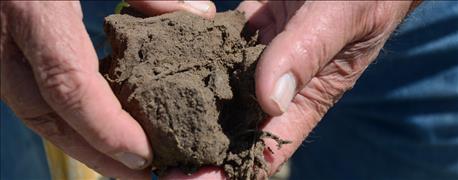
Mark Watson doesn't have a yield monitor in his combine. It's not for a lack of tech-savviness. It's because yield isn't his goal — he's interested in return on investment. "Yield doesn't matter," he says. "It's what you did to get to that yield that matters." That's something that's been a focus of Watson since he started no-tilling on his farm in Box Butte County back in the late 1980s.
Watson has used a rotation of winter wheat, corn and field peas on his farm off and on for almost as long as he's been no-tilling. In some years, he's substituted field peas with chickpeas or dry edible beans, but there has always been a three-year crop rotation with a legume.

BUILDING SOIL STRUCTURE: Mark Watson holds a clump of sandy Valentine soil on a field where he rotates from corn to field peas to winter wheat to dry edible beans with a forage crop in between the wheat and beans. With this kind of rotation and keeping the ground covered, he's building soil structure and water-holding capacity.
It started back in in the late 1980s, when Watson was still doing a wheat and summer fallow rotation. "One year we got cheatgrass sprayed, and then it started raining. By the time we could get in with a disk, the summer weeds that came in after we sprayed were as tall as the front axle on the tractor," he says. "I thought, 'If we can grow weeds like this in this stubble, why aren't we growing something that pays?' We went to a three-year field pea-corn-winter wheat rotation, which broke up the weed and disease problems associated with summer fallow."

CREATING A MARKET: Since the early 1990s, when he first started planting field peas, Mark Watson has been an advocate for expanding acres and building markets for field peas.
After Watson saw how well his winter wheat yielded following field peas, he became an advocate for the field peas in a no-till rotation. "You're getting the same wheat yield following the peas, maybe even better. If you can sustain yields, and make money with peas, obviously, your overall profitability goes up," he adds. "This year we've got $150 in them, and we expect to gross $270. I can't do that with corn. We look at peas as our most profitable crop, and that's at $7 a bushel."
Expanding field pea acres
Field pea acres continue to increase in Nebraska. In Box Butte County alone, acres have increased from 800 in 2011 to 5,300 in 2015, according to certified acre statistics from the Box Butte County Farm Service Agency office, and Watson estimates 40,000 to 50,000 acres in Nebraska now include field peas in the rotation.
"I thought if I could get one of our elevators to start handling field peas, there's a benefit for everybody," Watson says. "That's an obstacle with introducing alternative crops — you've got to have a market in place, and you've got to get through crop insurance issues. But we did get a good market for field peas and crop insurance available."
About five years ago, Stateline Bean Cooperative began handling field peas, and in 2014, Western Cooperative Co. picked up that torch when it acquired Stateline. "We found what fits this area well is dryland farming," says David Briggs, president and CEO at Westco, which has locations in Morrill, Gering, Alliance, Hemingford and Oshkosh. "We're encouraging farmers to continue farming their property and use less water. Field peas help do that, and put some nitrogen in the ground."
Briggs notes field peas are often used in dog food, livestock feed formulations and used internationally in human consumption. This year, Westco installed splitters to provide split peas for specific markets.
"People are growing a lot of field peas from Hastings on west," Briggs says. "If you have no difference in yield over wheat fallow and you have a profit with peas, it's a lucrative investment. Where we're at today, I think peas have a bright future. I really compare it to where we were in 1983 with the dry bean market."
Agronomic advantages to peas
But there are also agronomic advantages to including field peas in the rotation, Watson notes. The most notable is water. "Field peas grow during the time we usually get rain, while dry edible beans grow later in summer. You plant in June, and we don't typically get much rain in July and August," Watson explains. "Winter wheat needs 6 inches of rain for vegetative growth before it starts producing grain. Field peas only need 8/10 of an inch for vegetative growth, and they start adding grain after that. They only add about 3 bushels for every inch after that."
Watson's part of the state consists of silty loam to sandy soils. Rainfall is sparse – with an average of 14 inches annually. His irrigated acres are mostly made up of Valentine sand. "This sand is absolutely wonderful to farm in — if you can keep this layer of mulch on top so it doesn't blow away," he says. "You can start building structure even in really fine sand. If you can limit your water use through irrigation and keep the sand down so it doesn't blow away, you can raise some good crops on sand."
This is where a whole-systems approach to the rotation comes in. Because peas are harvested earlier, in July, he has an earlier window to plant winter wheat. Meanwhile, winter wheat yields benefit from higher organic matter, less evaporative water loss compared to a wheat-fallow rotation, a nitrogen credit from having a legume in the rotation, and reduced disease and weed pressure. "I think it's opened up opportunities to just continuous crop and put resources to work," he says. "We don't have the best soil, and it's a semi-arid climate, but we've got to put our resources together to make a living off the land."
About the Author(s)
You May Also Like






